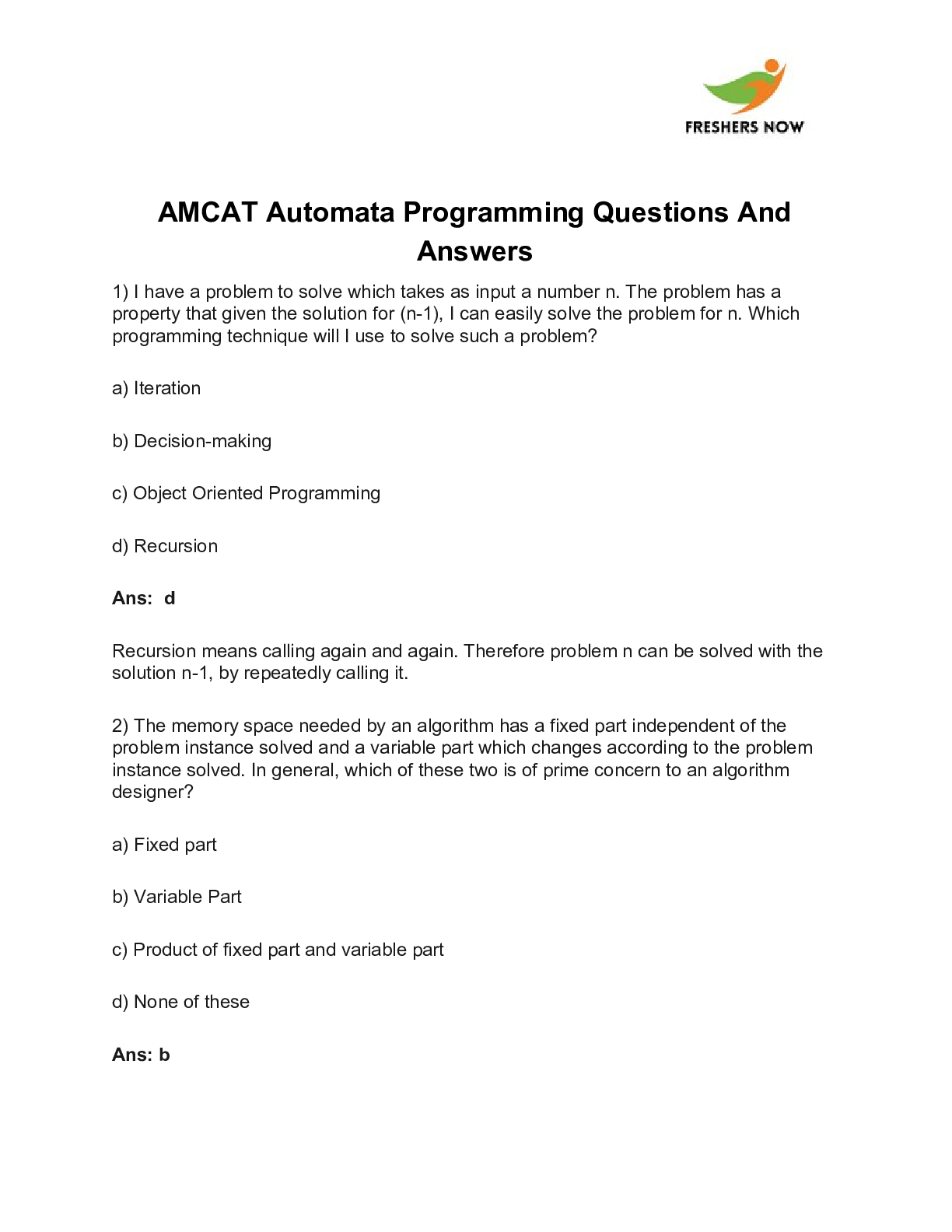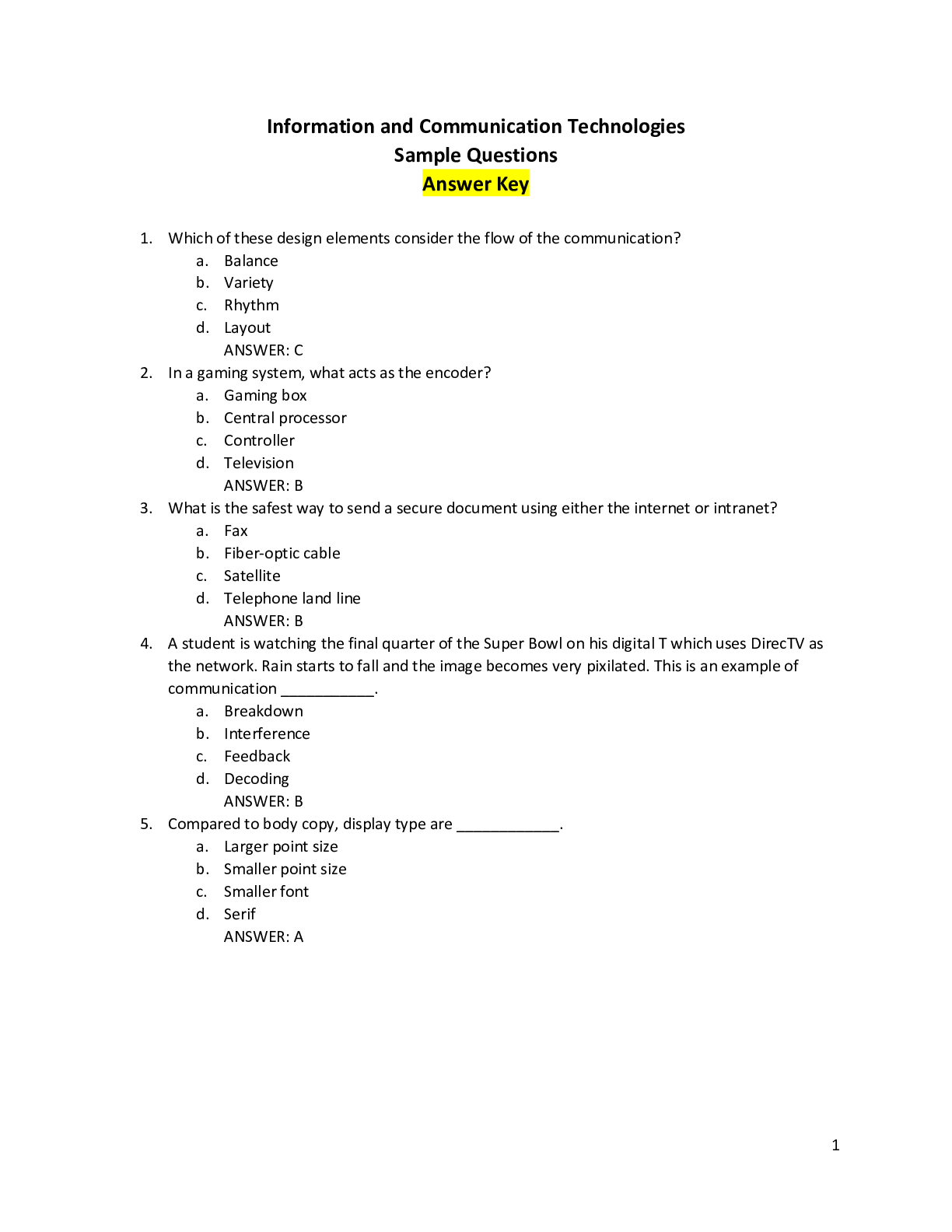*NURSING > QUESTIONS & ANSWERS > Exam 1 NR 324 Adult Health 1. All Questions with accurate answers. Graded A+ (All)
Exam 1 NR 324 Adult Health 1. All Questions with accurate answers. Graded A+
Document Content and Description Below
What age group has the highest percentage of water content? - ✔✔Preterm / Neonates Two fluid compartments in the body - ✔✔Intracellular space (inside cells) located in the ICF Extracellula... r space (outside cells) located in the ECF ICF makes up what percent of total body weight? - ✔✔40% What are the two main compartments containing ECF? What other compartments are there? - ✔✔Interstitial fluid (fluid in the spaces between cells) Intravascular fluid (plasma) Other compartments include lymph and transcellular fluids Transcellular fluid includes - ✔✔Cerebrospinal fluid, fluid in the gastrointestinal tract, and joint spaces as well as pleural, peritoneal, intraocular, and pericardial fluid. 1L of water = _____ lb. - ✔✔2.2 lb (1kg) The concentrations of electrolytes in body fluids is expressed in _________ - ✔✔milliequivalents (mEq) per Liter What are the main Ions found in the ECF and ICF - ✔✔ECF cation- sodium, with small amounts of potassium, calcium, and magnesium ECF anion- chloride, with small amounts of bicarbonate, sulfate, and phosphate anions. ICF cation- potassium, with small amounts of magnesium and sodium ICF anion- phosphate, with some protein and a small amount of bicarbonate. Hypovolemia (ECF volume deficit) - ✔✔abnormal loss of normal body fluids, (D/V, hemorrhage, polyuria) inadequate intake, or plasma-to-interstitial fluid shift Fluid volume deficit Assessment- Causes-Treatment-Client education - ✔✔Assessment- Restlessness, drowsiness, lethargy, confusion • Thirst, dry mucous membranes • Cold clammy skin • Decreased skin turgor, ↓ capillary refill • Postural hypotension, ↑ pulse, ↓ CVP • ↓ Urine output, concentrated urine • ↑ Respiratory rate • Weakness, dizziness • Weight loss • Seizures, coma Causes- • ↑ Insensible water loss or perspiration (high fever, heatstroke) • Diabetes insipidus • Osmotic diuresis • Hemorrhage • GI losses: vomiting, NG suction, diarrhea, fistula drainage • Overuse of diuretics • Inadequate fluid intake • Third-space fluid shifts: burns, pancreatitis Treatment- replace water and electrolytes with balanced IV solutions Client education- Good skin care, if orthostatic hypotension is present, teach to change positions slowly, remind patient to drink Hypervolemia (ECF volume excess) - ✔✔Excessive intake of fluids, abnormal retention of fluids (HF or renal failure), or interstitial-to-plasma fluid shift Fluid volume excess Assessment- Causes-Treatment-Client education - ✔✔Assessment- • Headache, confusion, lethargy • Peripheral edema • Jugular venous distention • S3 heart sound • Bounding pulse, ↑ BP, ↑ CVP • Polyuria (with normal renal function) • Dyspnea, crackles, pulmonary edema • Muscle spasms • Weight gain • Seizures, coma Causes- • Excessive isotonic or hypotonic IV fluids • Heart failure • Renal failure • Primary polydipsia • SIADH • Cushing syndrome • Long-term use of corticosteroids Treatment-Remove fluid without changing electrolyte composition or osmolality of ECF Client education- elevate edematous extremities Nutrition related to potassium - ✔✔Diet is the source -Fruit, dried fruits and vegetables -Many salt substitutes contain substantial K+ Nutrition related to sodium - ✔✔-Daily intake far exceeds bodys daily requirments -Glucose promotes sodium and water absorption Hypertonic solutions - ✔✔initially raises the osmolality of ECF and expands it -higher osmotic pressure draws water out of the cells into the ECF -Useful in treatment of hyponatremia and trauma patients with head injuries Isotonic solutions - ✔✔has a similar concentration of water and electrolytes to plasma, with an osmolality of 250 to 375 mOsm/L -administering an isotonic solution expands only ECF and the fluid does not move into cells -the ideal fluid replacement for patients with ECF volume deficits Hypotonic solutions - ✔✔solution has more water than electrolytes, with an osmolality of less than 250 mOsm/kg. -Infusing a hypotonic solution dilutes ECf -good for treating patients with hypernatremia As a nurse it is important to remember what administration guidelines when administering IV KCL? - ✔✔• IV KCl must always be diluted and never given in concentrated amounts. • Never give KCl via IV push or as a bolus. • Invert IV bags containing KCl several times to ensure even distribution in the bag. • Do not add KCl to a hanging IV bag to prevent giving a bolus dose. Hypernatremia - ✔✔Occurs when either too much water is lost or not enough water intake, or too much salt is taken in What S/S should the nurse look for when a patient is experiencing hypernatremia with decreased, normal and increased ECF volume? - ✔✔Hypernatremia with decreased ECF volume: • Restlessness, agitation, lethargy, seizures, coma • Intense thirst, dry swollen tongue, sticky mucous membranes • Postural hypotension, ↓ CVP, weight loss, ↑ pulse • Weakness, muscle cramps Hypernatremia with normal or increased ECF volume: • Restlessness, agitation, twitching, seizures, coma • Intense thirst, flushed skin • Weight gain, peripheral and pulmonary edema, ↑ BP, ↑ CVP Sodium plays a key role in the body by... - ✔✔Transmitting nerve impulses Hyponatremia - ✔✔Occurs when the body loses more sodium than water and there is a low level of sodium in the blood or when too much water is taken in or retained or when there is organ failure Hyperkalemia - ✔✔Occurs when potassium levels in your blood are higher than normal -Excess K+ intake -Shift of K+ out of cells -Failure to eliminate K+ Potassium is crucial for __________ and ____________ function within the body? - ✔✔Neuromuscular and cardiac function What S/S should the nurse look for when a patient is experiencing hyperkalemia? - ✔✔• Fatigue, irritability • Muscle weakness, cramps • Loss of muscle tone • Paresthesias, decreased reflexes • Abdominal cramping, diarrhea, vomiting • Confusion • Irregular pulse • Tetany What S/S should the nurse look for when a patient is experiencing hyponatremia with decreased, normal and increased ECF volume? - ✔✔Hyponatremia with decreased ECF volume: • Irritability, apprehension, confusion, dizziness, personality changes, tremors, seizures, coma • Dry mucous membranes • Postural hypotension, ↓ CVP, ↓ jugular venous filling, ↑ pulse, thready pulse • Cold and clammy skin Hyponatremia with normal or increased ECF volume: • Headache, apathy, confusion, muscle spasms, seizures, coma • Nausea, vomiting, diarrhea, abdominal cramps • Weight gain, ↑ BP, ↑ CVP Hypokalemia - ✔✔Occurs when potassium levels in your blood are lower than normal -K+ loss -Shift of K+ into cells -Lack of K+ intake What S/S should the nurse look for when a patient is experiencing hypokalemia? - ✔✔• Fatigue • Muscle weakness, leg cramps • Soft, flabby muscles • Paresthesias, decreased reflexes • Constipation, nausea, paralytic ileus • Shallow respirations • Weak, irregular pulse • Hyperglycemia Hypermagnesmia - ✔✔Occurs when magnesium levels in your blood are higher than normal Magnesium is responsible for what reactions in the body? - ✔✔Reactions that involve muscle function, energy production, and carbohydrate and protein metabolism What S/S should the nurse look for when a patient is experiencing hypermagnesemia? - ✔✔• Lethargy, drowsiness • Muscle weakness • Urinary retention • Nausea, vomiting • Diminished deep tendon reflexes • Flushed, warm skin, especially facial • ↓ Pulse, ↓ BP What S/S should the nurse look for when a patient is experiencing hypomagnesemia? - ✔✔• Confusion • Muscle cramps • Tremors, seizures • Vertigo • Hyperactive deep tendon reflexes • Chvostek's and Trousseau's signs • ↑ Pulse, ↑ BP, dysrhythmias Hypomagnesemia - ✔✔Occurs when magnesium levels in your body are lower than normal -associated with high mortality rates Calcium plays what role in the body? - ✔✔Plays a role in blood clotting, transmission or nerve impulses, myocardial contractions, and muscle contractions -Major cation in bones and teeth Hypercalcemia - ✔✔Excess calcium leading to reduced excitability of muscles and nerves -causes by hyperparathyroidism in about 2/3 of persons -the other 1/3 come from hematologic, breast, and lung cancers Patients with hypocalcemia could have what conditions or problems leading to low calcium? - ✔✔Surgical removal of parathyroid gland Multiple blood transfusions Sudden alkalosis Malnutrition Acute pancreatitis Renal insufficiency Primary hypoparathyroidism Chronic alcoholism What S/S should the nurse look for when a patient is experiencing hypercalcemia? - ✔✔Manifestations • Lethargy, weakness, fatigue • Decreased memory • Depressed reflexes • ↑ BP • Confusion, psychosis • Anorexia, nausea, vomiting • Bone pain, fractures • Polyuria, dehydration • Nephrolithiasis • Seizures, coma -ventricular dysrhythmias Hypocalcemia - ✔✔Low calcium levels from decreased total calcium or decreased ionized calcium -low ionized calcium levels decrease the threshold for activating the sodium channels resulting in increased nerve excitability and sustained muscle contraction Low ionized calcium levels can lead to tetany, as a nurse you know that clinical signs of tetany include - ✔✔Chvostek's sign (contraction of facial muscles and Trousseau's sign (carpal spasms induced by BP cuff on arm) What S/S should the nurse look for when a patient is experiencing hypocalcemia? - ✔✔• Weakness, fatigue • Depression, irritability, confusion • Hyperreflexia, muscle cramps • ↓ BP • Numbness and tingling in extremities and region around mouth • Chvostek's sign • Trousseau's sign • Laryngeal and bronchial spasms • Tetany, seizures -Tachycardia Hypomagnesemia can be associated with what conditions? - ✔✔Diuretic therapy, chronic alcoholism, cirrhosis, pancreatitis, and preeclampsia A patient comes to the clinic complaining of fatigue, lethargy, weakness, and confusion. As a nurse you know these symptoms are begining neurologic manifestations of what electrolyte imbalance? - ✔✔Hypercalcemia What health problems frequently lead to acid-base imbalances? - ✔✔Diabetes mellitus, COPD, and kidney disease Normal pH range - ✔✔7.35-7.45 Acid-Base regulatory mechanisms - ✔✔Buffers- react immediately Respiratory system- responds in minutes and reaches max effectiveness in hours Renal system- takes 2 to 3 days to respond, but kidneys can maintain balance indefinitely in chronic imbalances Interpret the ABG: pH 7.5, CO2 25, HCO3 25 - ✔✔Respiratory alkalosis Interpret the ABG: pH 6.96, PaO2 55, CO2 65, HCO3 16 - ✔✔Combined respiratory and metabolic acidosis [Show More]
Last updated: 2 years ago
Preview 1 out of 51 pages

Buy this document to get the full access instantly
Instant Download Access after purchase
Buy NowInstant download
We Accept:

Reviews( 0 )
$12.00
Can't find what you want? Try our AI powered Search
Document information
Connected school, study & course
About the document
Uploaded On
Aug 16, 2022
Number of pages
51
Written in
Seller

Reviews Received
Additional information
This document has been written for:
Uploaded
Aug 16, 2022
Downloads
0
Views
133
















 ATI RN Fundamentals Proctored Focus, Latest Questions and Answers with Explanations, All Correct Study Guide.png)






